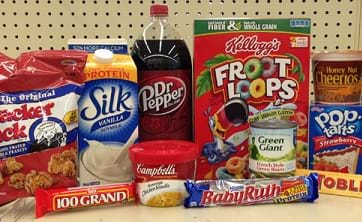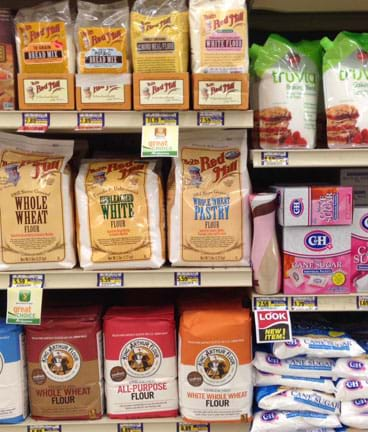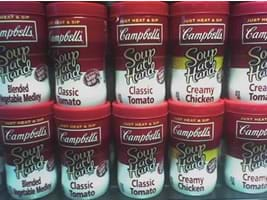Quick Look
Grade Level: 7 (6-8)
Time Required: 30 minutes
Lesson Dependency: None
Subject Areas: Chemistry, Science and Technology
NGSS Performance Expectations:

| MS-ETS1-1 |

Summary
Students learn how food packages are designed and made, including three main functions. Packaging design and materials must keep food clean, protect or aid in the physical and chemical changes that can take place in food, and identify a food appealingly. Then, in the associated activity, students act as if they are packaging engineers by designing and creating their own food packages for particular food types.Engineering Connection
An entire industry is devoted to packaging engineering and the industry is expanding as more and more products are created. Packaging engineers focus on the same components that students focus on in this exercise, which includes research, design, production, marketing and analysis.
Learning Objectives
After this activity, students should be able to:
- Identify four functions of a food package.
- Explain how each food package design works.
- Identify the chemical and physical changes different types of materials prevent or facilitate.
- Explain what a food packaging engineer does.
Educational Standards
Each TeachEngineering lesson or activity is correlated to one or more K-12 science,
technology, engineering or math (STEM) educational standards.
All 100,000+ K-12 STEM standards covered in TeachEngineering are collected, maintained and packaged by the Achievement Standards Network (ASN),
a project of D2L (www.achievementstandards.org).
In the ASN, standards are hierarchically structured: first by source; e.g., by state; within source by type; e.g., science or mathematics;
within type by subtype, then by grade, etc.
Each TeachEngineering lesson or activity is correlated to one or more K-12 science, technology, engineering or math (STEM) educational standards.
All 100,000+ K-12 STEM standards covered in TeachEngineering are collected, maintained and packaged by the Achievement Standards Network (ASN), a project of D2L (www.achievementstandards.org).
In the ASN, standards are hierarchically structured: first by source; e.g., by state; within source by type; e.g., science or mathematics; within type by subtype, then by grade, etc.
NGSS: Next Generation Science Standards - Science
| NGSS Performance Expectation | ||
|---|---|---|
|
MS-ETS1-1. Define the criteria and constraints of a design problem with sufficient precision to ensure a successful solution, taking into account relevant scientific principles and potential impacts on people and the natural environment that may limit possible solutions. (Grades 6 - 8) Do you agree with this alignment? |
||
| Click to view other curriculum aligned to this Performance Expectation | ||
| This lesson focuses on the following Three Dimensional Learning aspects of NGSS: | ||
| Science & Engineering Practices | Disciplinary Core Ideas | Crosscutting Concepts |
| Define a design problem that can be solved through the development of an object, tool, process or system and includes multiple criteria and constraints, including scientific knowledge that may limit possible solutions. Alignment agreement: | The more precisely a design task's criteria and constraints can be defined, the more likely it is that the designed solution will be successful. Specification of constraints includes consideration of scientific principles and other relevant knowledge that is likely to limit possible solutions. Alignment agreement: | All human activity draws on natural resources and has both short and long-term consequences, positive as well as negative, for the health of people and the natural environment. Alignment agreement: The uses of technologies and any limitations on their use are driven by individual or societal needs, desires, and values; by the findings of scientific research; and by differences in such factors as climate, natural resources, and economic conditions.Alignment agreement: |
International Technology and Engineering Educators Association - Technology
-
Technological advances in agriculture directly affect the time and number of people required to produce food for a large population.
(Grades
6 -
8)
More Details
Do you agree with this alignment?
-
A wide range of specialized equipment and practices is used to improve the production of food, fiber, fuel, and other useful products and in the care of animals.
(Grades
6 -
8)
More Details
Do you agree with this alignment?
-
Biotechnology applies the principles of biology to create commercial products or processes.
(Grades
6 -
8)
More Details
Do you agree with this alignment?
-
Artificial ecosystems are human-made complexes that replicate some aspects of the natural environment.
(Grades
6 -
8)
More Details
Do you agree with this alignment?
-
The development of refrigeration, freezing, dehydration, preservation, and irradiation provide long-term storage of food and reduce the health risks caused by tainted food.
(Grades
6 -
8)
More Details
Do you agree with this alignment?
State Standards
North Carolina - Science
-
Explain how the properties of some materials change as a result of heating and cooling.
(Grade
5)
More Details
Do you agree with this alignment?
-
Illustrate the transfer of heat energy from warmer objects to cooler ones using examples of conduction, radiation and convection and the effects that may result.
(Grade
6)
More Details
Do you agree with this alignment?
-
Understand characteristics of energy transfer and interactions of matter and energy.
(Grade
6)
More Details
Do you agree with this alignment?
-
Explain the suitability of materials for use in technological design based on a response to heat (to include conduction, expansion, and contraction) and electrical energy (conductors and insulators).
(Grade
6)
More Details
Do you agree with this alignment?
Worksheets and Attachments
Visit [www.teachengineering.org/lessons/view/duk_foodpackage_music_less] to print or download.Pre-Req Knowledge
Prior to this activity, students should have a basic understanding of the following:
Physical properties of matter: mass, volume, melting point, boiling point and texture.
Chemical properties of matter: combustibility, solubility, flammability.
Physical changes: phase change, shape change.
Chemical changes: oxidization, evolution of gas.
Introduction/Motivation
(Have handy an assortment of food packaging examples to show students, such as a plastic or glass soda bottle, bag of flour, soup or noodles that can be cooked or heated in their containers, food in a plastic bag, milk carton, cracker or cereal box, chips bag, candy wrapper.)
Did you know that a huge field of engineering exists with the purpose of designing packages for different food products? Today, we are going to look at some packages that engineers have already designed and see why they made them the way they did. Do you ever drink a beverage from a plastic or glass bottle? (Hold up a soda bottle.) Have you ever wondered why a bottle is designed the way it is? What are some of the qualities of this bottle and the reasons why the bottle has those characteristics? (Listen to student ideas and write them on the classroom board.)

Now, lets look at this bag of flour. (Hold up a bag of flour.) What is different about the characteristics of this bag compared to those of a soda bottle? (Main differences: material and structure.) Why do you think that the bag is so different from the bottle?
Now look at these two other packages. (Hold up a package of soup or noodles that can be heated and a food in a plastic bag.) Please write down the qualities of these packages and why you think they have those characteristics.
Considering all these packaging examples and the reasons for each of the packages, let's brainstorm three important functions of food packages, besides contaiig the food.
- To keep the food clean.
- To protect the food product from unwanted physical and chemical changes (such as oxidation and destruction from insects) and to facilitate in desired physical changes (such as heating or cooling).
- To identify the product and provide sales appeal.
Now please write beside each characteristic you wrote down, what function is being fulfilled. As you can see, the materials that make a package plays a huge role in its functioning. If you want to be able to put your food and package in the microwave, would you make the package of metal? Why not? If you want to make sure your food will not be crushed by something heavy, would you put your food in a plastic bag? Would you put a liquid in a package made of paper?
Besides a package's materials, its structural design is very important for its functions. What type of food package structures can you think of?
- cartons (milk carton)
- boxes (cereal box)
- bags (bag of chips/bag of vegetables)
- cans (can of soup)
- bottles (bottle of soda)
- wrappers (candy)
What are the advantages and disadvantages of these package structures?
Let's look at these two different packages for the same food. (Bring out a food packaged aesthetically and the same food packaged less appealingly.) Which one would you rather buy? What qualities does that package have that the other does not? (A symmetrically shaped package, a pretty label, a nicely colored package, etc).
Lesson Background and Concepts for Teachers

Food packages have four main functions besides providing food containers.
- To keep the food clean.
- To protect the food product from unwanted physical and chemical changes (such as oxidation and destruction from insects) and to facilitate in desired physical changes (such as heating or cooling).
- To identify the product and provide sales appeal.
- To be inexpensive and economical, both in its materials and its transportation.
In this lesson, a focus on the first three functions of food packages provides a great introduction to how package materials are chosen. The first function is pretty simple to fulfill; packaging materials prevent dirt from getting into food. Fresh produce is an exception to this approach since a fruit or vegetable's skin protects its insides from contamination and consumers are expected to clean the produce before eating. Thus, natural fruit and vegetables are basically "self-packaged."
The second function of food packages is probably one of the hardest to understand. A number of physical changes can be considered for this function. The main physical change that can occur is physical damage. Food can be crushed and damaged without the proper protection from its package. Chalenge students to design a packaging of their own following the mentioned functions with the Package Those Foods! activity.
Another physical change that children can relate to is soda going flat. The scientific word for this happening is effervescence, which is the escape of air bubbles from a liquid. This physical change occurs when a carbonated beverage is opened. The carbonation quickly escapes through the opening. Students should consider this physical change in the packaging of beverages. Bottles can be resealed to prevent the further escape of air bubbles while cans cannot.
Also many children are familiar with mixing. By mixing, we mean to disperse one substance throughout another, usually by swirling. A food example is dissolving a lemonade powder in water. This process is not a chemical change because the water and powder do not form a new chemical. The powder is solely dispersed evenly throughout the water to make a mixture of individual water and lemonade molecules.
One example of a major physical change is phase change. Phase changes occur if a food changes state between solid, liquid or gas. An example of a food whose package must consider phase change is ice cream. An ice cream carton is meant to hold an almost solid ice cream. However, the design must also anticipate liquid in case of melting. The design must also be capable of being put in the freezer and also taken out by the consumer. Thus, a good point to make is that a food package designer would not make an ice cream package of metal because it would be too cold to touch and remove from the freezer. Also, designs for packages for foods that are meant to be warmed up in microwaves must take into account the melting point (the temperature at which a material changes from solid to liquid) of the package materials. If a package is to be microwaved, a material with a low melting point would not be a good choice, since the package would melt into the food!
A major chemical change involved in the creation of food packages is organic growth in foods. Organic growth occurs by microorganisms, which feed on foods. As microorganisms feed, the food rots and the microorganisms multiply. It is not eating the rotten food that makes a person sick, but eating the vast number of microorganisms on that food. Microorganism growth can include the growth of bacteria, molds and yeast. Microorganisms grow and affect different foods at different rates.The package in which a food is held affects a food's rate of organic change.
Such organic change affects how long a food can be stored before and after its opening. Plastics and cans do not allow moisture to seep into the food product that they hold. Thus, they keep microorganisms from outside away from the food. Vacuum sealing removes all of the oxygen from a food. Without oxygen, microorganisms cannot grow and so the food does not rot. If a food's microorganisms are removed through processing, these packages prevent most organism growth in the food and enable its shelf life to be long. These non-perishable foods can last for two years or longer.
After opening a food package, however, microorganisms in the air can quickly get into the package to start an organic degradation of the food. This event is why food packages say, "refrigerate after opening." Microorganisms can only grow in certain temperatures so refrigeration slows rotting and freezing usually stops degradation altogether. In spite of this, naturally non-perishable foods whose majority is not fruit, vegetable, nut oil or dairy are okay if not refrigerated for a reasonable amount of time since their rate of organic change is very slow.
Many different processes exist to make a food non-perishable, as discussed earlier. A common process is thermal processing, in which foods are treated with heat to destroy all microorganisms. Thermal processing takes less energy for plastic-packaged foods than-metal packaged foods. Thus, taste is preserved more in plastic-packaged food than canned food. This is a major advantage to use plastic in packaging rather than metal.
Since paper packages permit the entrance of oxygen and moisture, they usually hold foods whose rate of organic change is very slow or foods whose consumption is assumed to happen within days of production.
Despite the physical and chemical changes that some materials may prevent or encourage, all materials have advantages and disadvantages, which are listed in the Food Packaging Materials Worksheet.
Associated Activities
- Package Those Foods! - Students create their own food packages, meeting the requirements of the three main functions of food packages.
Vocabulary/Definitions
boiling point: The temperature at which a substance changes from liquid to gas.
melting point: The temperature at which a substance changes from solid to liquid.
phase change: A transition between liquid and gas or liquid and solid.
solubility: The ability of a substance, the solute, to dissolve in a solvent.
Assessment
Food Analysis: Ask students to analyze the physical properties of foods and identify the chemical and physical changes that they need to pay attention to in the creation of their food packages. Have them describe how they would address each of the functions of a food package.
Subscribe
Get the inside scoop on all things TeachEngineering such as new site features, curriculum updates, video releases, and more by signing up for our newsletter!More Curriculum Like This

This lesson introduces students to the main parts of the digestive system and how they interact. In addition, students learn about some of the challenges astronauts face when eating in outer space. Engineers figure out how to deal with such challenges.
References
American Management Association. Packaging Division. Packaging for Retail Impact, with Specific Applications to the Dairy, Meat, Candy and Baking Industries. New York, NY: American Management Association, 1965.
Copyright
© 2013 by Regents of the University of Colorado; original © 2007 Duke UniversityContributors
Chloe MawerSupporting Program
Engineering K-PhD Program, Pratt School of Engineering, Duke UniversityAcknowledgements
This content was developed by the MUSIC (Math Understanding through Science Integrated with Curriculum) Program in the Pratt School of Engineering at Duke University under National Science Foundation GK-12 grant no. DGE 0338262. However, these contents do not necessarily represent the policies of the NSF, and you should not assume endorsement by the federal government.
Last modified: February 25, 2020







User Comments & Tips